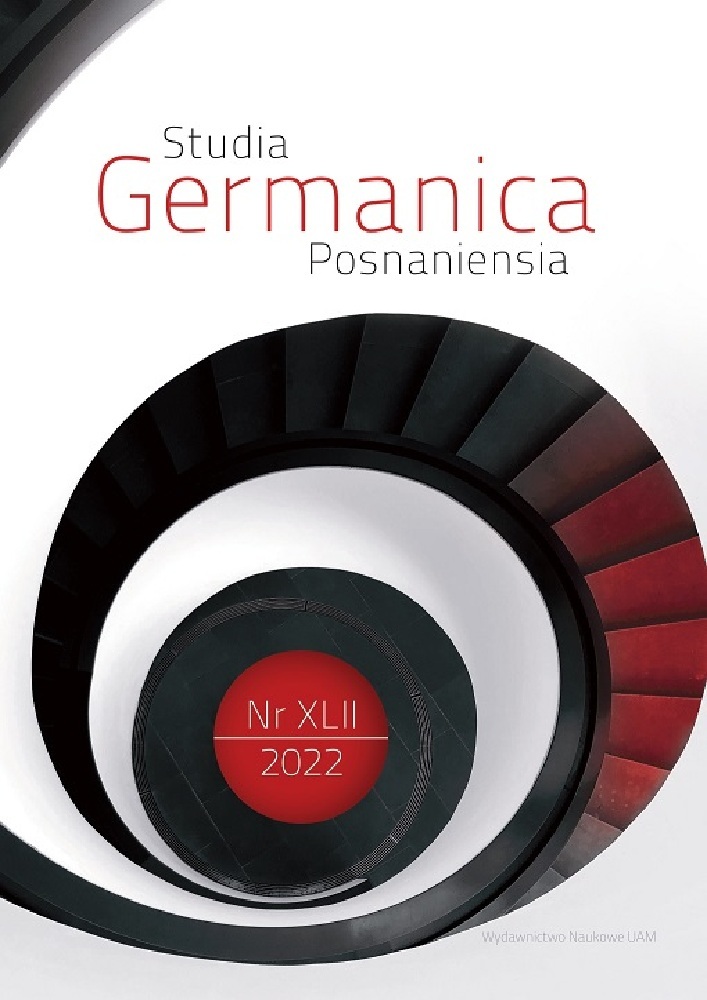Abstrakt
Pilze trenden: Sowohl in der zeitgenössischen Kulturtheorie und Philosophie als auchin Kunst, Literatur und Film tritt das Fungale als eine Denkfigur auf, die den Herausforderungen unserer anthropozänen Gegenwart besonders entgegen zu kommen scheint. Der Beitrag vollzieht zunächst nach, wie und zu welchem Zweck diese Denkfigur in Rahmen neumaterialistischer und posthumanistischer Positionen in der Theorie und in der populären Wissenschaftsliteratur in Merlin Sheldrakes Entangled Life verhandelt wird, und arbeitet heraus, was sie für Diskurse um posthumane Subjekte und Ästhetiken liefern kann. Im Anschluss wird beispielhaft an Texten von Hugo von Hofmannsthal, Thomas Melle, Peter Handke, Richard Powers und Martin MacInnes, an einer Video-Installation und an dem Horrorfilm In the Earth analysiert, wie eine Aisthesis des Fungalen als posthumanistische Ästhetik zum Einsatz kommt. Die epistemische, ästhetische und poetologische Reflektion der Denkfigur des Fungalen am Ende des Anthropozäns wird dabei als ein ‚becoming fungal‘ untersucht, dessen Potenzial nicht nur in einer neuen Perspektive auf die Rolle des Menschen in einer kollaborativen, wandelhaften Ökologie liegt, sondern auch in einem das menschliche Selbstbewusstsein nicht unbeschadet lassenden Neuverständnis epistemischer Prozesse, kognitiver Phänomene und posthumanen Entanglements.
Bibliografia
Albus, A. (2015). Pilzpanorama. Panorama mycologique. In J.-H. Fabre (Hrsg.), Pilze. Naturkunden (S. 6-17). Berlin: Matthes & Seitz.
Barad, K. (2003). Posthumanist Performativity. Toward an Understanding of How Matter Comes to Matter. Signs, 28 (3), 801-803. DOI: https://doi.org/10.1086/345321
Barad, K. (2015). Nature’s Queer Performativity. In C. Riechelmann & B. Oetker (Hrsg.), Toward an Aesthetics of Living Beings / Zu einer Ästhetik des Lebendigen (S. 250-261). Berlin: Sternberg Press.
Bennett, J. (2010). Vibrant Matter. A Political Ecology of Things. Durham, London: Duke University Press. DOI: https://doi.org/10.1215/9780822391623
Boehm, G. (1985). Bildnis und Individuum. Über den Ursprung der Porträtmalerei in der italienischen Renaissance. München: Prestel 1985.
Braidotti, R. (2013). The Posthuman. Cambridge, Malden: Polity Press.
Breyer, M. (2019). Sensualizing the „Over There“. The Dissolving of Exteriority and Interiority in „Geothoughts“ and „Geo-song“. In D. Bauer & M.J. Kelly (Hrsg.), The Imagery of Interior Spaces (S. 57-76). Santa Barbara: punctum. DOI: https://doi.org/10.2307/j.ctv19cwdj8.6
Bruns, G.L. (2007). Becoming-Animal (Some Simple Ways). New Literary History, 38 (4), 703-720. DOI: https://doi.org/10.1353/nlh.2008.0003
Fabre, J.-H. (2015). Pilze. Naturkunden. Berlin: Matthes & Seitz.
Fritsch, E. (2021). Der Pilzkurs. Ein szenografischer Waldspaziergang. Masterarbeit im Bereich Bühnenbild. Zürich: Hochschule der Künste. Abgerufen von https://www.der-pilzkurs.ch.
Griffiths, D. (2015). Queer Theory for Lichens. UnderCurrents, 19 (1), 36-45. DOI: https://doi.org/10.25071/2292-4736/40249
Haididi, R. (2021). In the Earth finds psychedelic terror in the void between technology and magic. Polygon. Abgerufen von https://www.polygon.com/movies/22386347/in-the-earth-review.
Hálek, V. (2003). Hudební atlas hub. Olomouc: Fontana.
Handke, P. (2013). Versuch über den Pilznarren. Berlin: Suhrkamp.
Handke, P. (2020). 19 Pilzdrucke. München: Schirmer & Mosel.
Haraway, D.J. (2009). Becoming-with-Companions. Sharing and Response in Experimental Laboratories. In T. Tyler & M. Rossini (Hrsg.), Animal Encounters (S. 115-136). Leiden: Brill. DOI: https://doi.org/10.1163/ej.9789004168671.i-266.28
Haraway, D.J. (2016). Staying with the Trouble. Making Kin in the Chthulucene. Durham, London: Duke University Press. DOI: https://doi.org/10.2307/j.ctv11cw25q
Hofmannsthal, H. v. (2019). Der Brief des Lord Chandos (F. Lönker, Hrsg.). Stuttgart: Reclam (Originalwerk veröffentlicht 1902). In the Earth (2021). Regie: Ben Wheatley. UK.
King, M. (2012). Sprachkrise. In H. Feger (Hrsg.), Handbuch Literatur und Philosophie (S. 159-177). Stuttgart, Weimar: Metzler. DOI: https://doi.org/10.1007/978-3-476-00336-2_9
Lehmkuhl, T. (2020). Leidenschaften eines Waldgängers [Besprechung von Peter Handke 19 Pilzdrucke]. Deutschlandfunk Kultur. Abgerufen von https://www.deutschlandfunkkultur.de/peter-handke-19-pilzdrucke-leidenschaften-eines-waldgaengers-100.html.
MacInnes, M. (2020). Gathering Evidence. London: Atlantic Books.
Melle, T. (2007). Wuchernde Netze. In T. Melle, Raumforderung (S. 144-166). Frankfurt a. M.: Suhrkamp.
Müller, E. (2013). Denkfigur. In R. Borgards, H. Neumeyer, N. Pethes & Y. Wübben (Hrsg.), Literatur und Wissen. Ein interdisziplinäres Handbuch (S. 28-32). Stuttgart, Weimar: Metzler.
Müller-Tamm, J. (2014). Die Denkfigur als wissensgeschichtliche Kategorie. In N. Gess & S. Janßen (Hrsg.), Wissens-Ordnungen. Zu einer historischen Epistemologie der Literatur (S. 100-122). Berlin, Boston: De Gruyter. DOI: https://doi.org/10.1515/9783110350401.100
MycoWorks (2022). Our Heritage. Abgerufen von https://www.mycoworks.com/our-heritage.
Perry, M. (2019). Mushroom Orchestra. Videoinstallation.
Peter Handke Kosmos (2022). Pilze [Stichwort]. Abgerufen von https://peter-handke.de/kosmos/pilze/.
Powers, R. (2018). The Overstory. London: Vintage.
Pyne, L. (2020). A Mycological Foray. A New Look at John Cage and His Mushroom Obsession. Glasstire. Abgerufen von https://glasstire.com/2020/07/11/a-mycological-foray-a-new-look-at-john-cage-andhis-mushroom-obsession/.
Rust, S.A. & Soles, C. (2014). Ecohorror Special Cluster: „Living in Fear, Living in Dread, Pretty Soon DOI: https://doi.org/10.1093/isle/isu085
We’ll All Be Dead“. ISLE, 21 (3), 509-512.
Shah, M. (2021). Thinking with the Trouble. Mooni Perrys Kunst der Wahrnehmung. In M. Jeon & M. Legemah
(Hrsg.), ars viva 2022. Tamina Amadyar – Lewis Hammond – Mooni Perry (S. 115-127). Bielefeld, Berlin: Kerber.
Sheldrake, M. (2020). Entangled Life. How Fungi Make Our Worlds, Change Our Minds, and Shape our Futures. London: Vintage.
Slézec, A.-M. (2015). Vergängliche Schönheiten. Des beautés éphémères. In J.-H. Fabre, Pilze. Naturkunden (S. 590-611). Berlin: Matthes & Seitz.
Suter, M. (2000). Die dunkle Seite des Mondes. Zürich: Diogenes.
Taylor, M. (2012). The Nature of Fear. Edgar Allan Poe and Posthuman Ecology. American Literature, 84, 353-379. DOI: https://doi.org/10.1215/00029831-1587377
Torra-Mattenklott, C. (2013). Denkfiguren. In J. Küpper, M. Schaub, R. Strätling & M. Rautzenberg (Hrsg.), The Beauty of Theory. Zur Ästhetik und Affektökonomie von Theorien (S. 59-76). Leiden: Brill. DOI: https://doi.org/10.30965/9783846750230_006
Tsing, A. (2015). The Mushroom at the End of the World. On the Possibility of Life in Capitalist Ruins. Princeton, Oxford: Princeton University Press. DOI: https://doi.org/10.1515/9781400873548
Wikipedia (2022). Star Trek: Discovery/Staffel 1 [Stichwort]. Wikipedia.de. Abgerufen von https://de.wikipedia.org/wiki/Star_Trek:_Discovery/Staffel_1.
Zivlar, T. & Brousil, R. (2011). Der Pilzflüsterer. Vice. Abgerufen von https://www.vice.com/de/article/vdnv5a/der-pilzfluesterer.
Licencja
Prawa autorskie (c) 2022 Mira Shah

Utwór dostępny jest na licencji Creative Commons Uznanie autorstwa – Bez utworów zależnych 4.0 Międzynarodowe.
